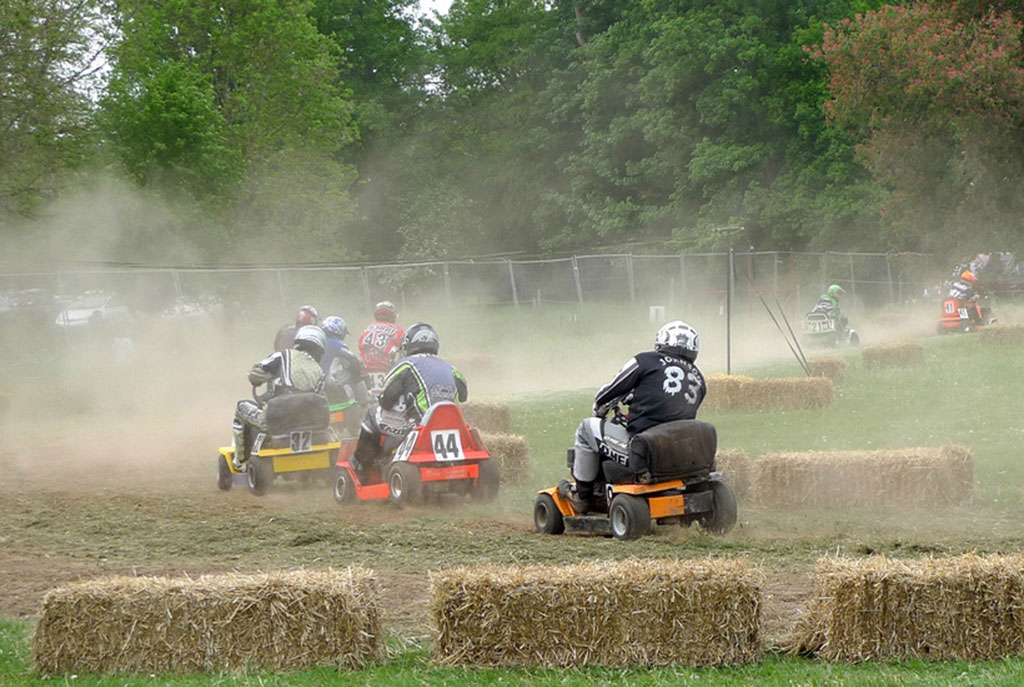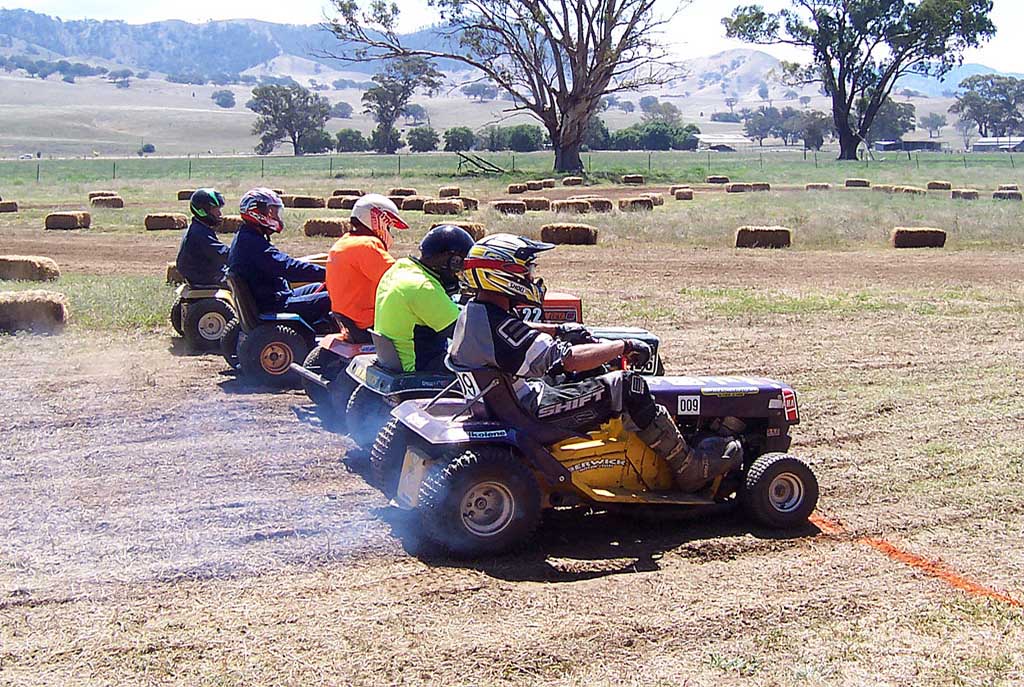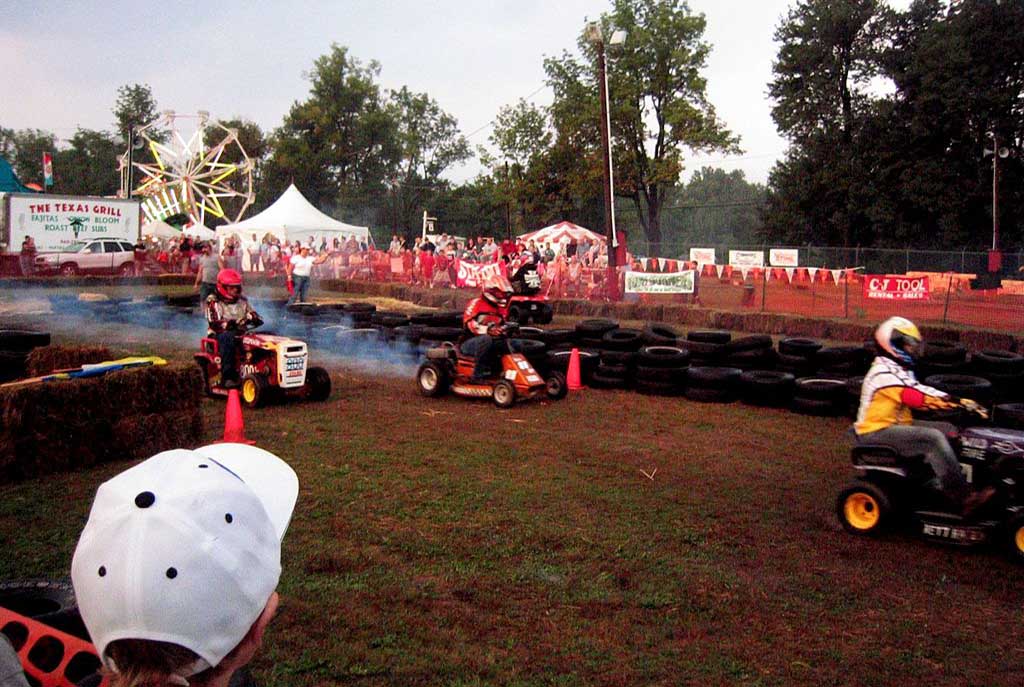Lawn mower racing is a much-loved pastime across the world with plenty of dedicated riders. Created as a sport intended to reject sponsorship and commercialization, this activity’s affordability makes it a great deal of fun easily accessible for anybody out there with a need for speed. So where did this unorthodox, yet down-to-earth extreme sport come from? Find out in this brief history of lawn mower racing.
Photo by: Jens Stenneken License: CC
Lawn Mower Racing in the UK

Photo by: Henry Burrows License: CC
British lawnmower racing has its roots tracing back to 1973. Its inception is credited to an Irishman named Jim Gavin, who discussed his motorsport idea over a few pints one lunchtime at the Cricketers Arms in Wisborough Green, West Sussex. As someone who was heavily involved with rallying sports, Jim was opposed to their growing commercialization, with sponsors creeping in from all sides. The idea was to come up with a rallying sport that was budget-friendly and readily accessible to all, regardless of income.
Realising that everyone in the group had a lawnmower in their gardens shed, they decided to race them. When it was announced that the inaugural lawnmower race would take place in a local field, about 80 lawnmowers turned up.
To this day the main objectives and hallmarks of lawnmower racing remain the same as when the sport started: no sponsorship, no commercialism, no cash prizes and no modification of engines. All of this serves to keep the costs down and it worked. Motor Sport News has described it as “the cheapest form of motorsport in the UK”.
The British Lawnmower Racing Association (BLMRA) is alive and kicking today across the British Isles. It still sticks to its origins as a non-profit organization with any proceeds going to charities or good causes.
Lawn Mower Racing takes place across the Isles and appears at numerous Country Shows, Fayres and Steam Rallies. The racing season is usually May to October and incorporates the British Championship.
The BLMRA website outlines four categories of race, each involving a different class of lawn mower:
Group 1: “The basic cylinder mower often found in the back of your Grandfather’s shed such as the Suffolk Colt and Punch or picked up from the local council tip!”
Group 2: “Roller driven mowers of the cylinder type often see used on a Sunday afternoons preparing cricket pitches and lawns around Villages and Hamlets.”
Group 3: “Wheel driven mowers originally designed, manufactured and sold to mow domestic lawns, not game fields, golf courses or the rolling prairies of the American Mid-West.”
Group 4: “Wheel driven lawn tractors. They are similar mechanically to Group 3 with the obvious difference that they have a bonnet over a front mounted engine.”
Lawn Mower Racing in the US

Photo by: Fir0002 License: CC
There is just as much of a following across the pond in the United States with its origins reaching back decades also. The event began as a humble race between factory-built mowers with their blades removed. Nowadays, both original model and modified mowers are permitted to race. The two major governing bodies in the USA are the American Racing Mower Association (ARMA) and the more historical United States Lawn Mower Racing Association. This organisation celebrated 25 year of activity last year. Both organisations work to promote and co-ordinate lawn mower races throughout North America.
According to popularmechanics.com, “ARMA competitions allow racers to ride any self-propelled rotary or reel-style riding lawnmower (but not zero-turns), so long as it was originally designed and sold to mow lawns, and it must remain suitable for lawn cutting, though for safety’s sake the blades are removed on racing mowers. Riders can tinker with the engines and transmissions but must use ones made for mowers.”
Are you up for the challenge?

Photo by: Plutor License: CC
Think you’d like to take part in this niche motor sport?
The first step is check out a local event to see if the urge to hop on one of those machines are start racing around grabs you.
If so, you will need to sign up to become a member of one of the aforementioned organizations, either online or by filling in a form. Once you’ve done this, you’ll receive all the necessary information to get started and a membership card.
After reading up on the material and selecting your race group, you will need to get yourself a mower and get it inspected and approved for the track. All lawnmowers will need to adhere to strict regulations to ensure a level playing field for all racers.
It will need to be inspected once more before you race.
You will need a safety helmet, and goggles if you will be using an open faced style helmet, as well as gloves for driving. Most riders opt to don protective motocross clothing with extra layers of body armor for added protection.
With all this checked off, you’ll be ready to have a rip roaring time in your first lawn mower race!
Liked this article? Looking for the latest in travel and adventure news? Then check out the rest of our articles at Adventure Herald. You can also like us on Facebook, follow us on Twitter or Instagram to keep up with our latest antics.
About the author
Fiona
Fiona is half Irish-half Italian and currently lives in Budapest. She is passionate about sustainability and loves nature, traveling and vegan food.
In adventure travel news, n innovative new natural desert reserve spanning 10 percent of the total area of Dubai has been launched in the UAE. The Marmoon Desert Reserve Project is set to be the site of several ecotourism projects and conservation efforts contributing to the protection and nurturing of the environment,…
Hot Topics
In adventure travel news, n innovative new natural desert reserve spanning 10 percent of the total area of Dubai has been launched in the UAE. The Marmoon Desert Reserve Project is…














